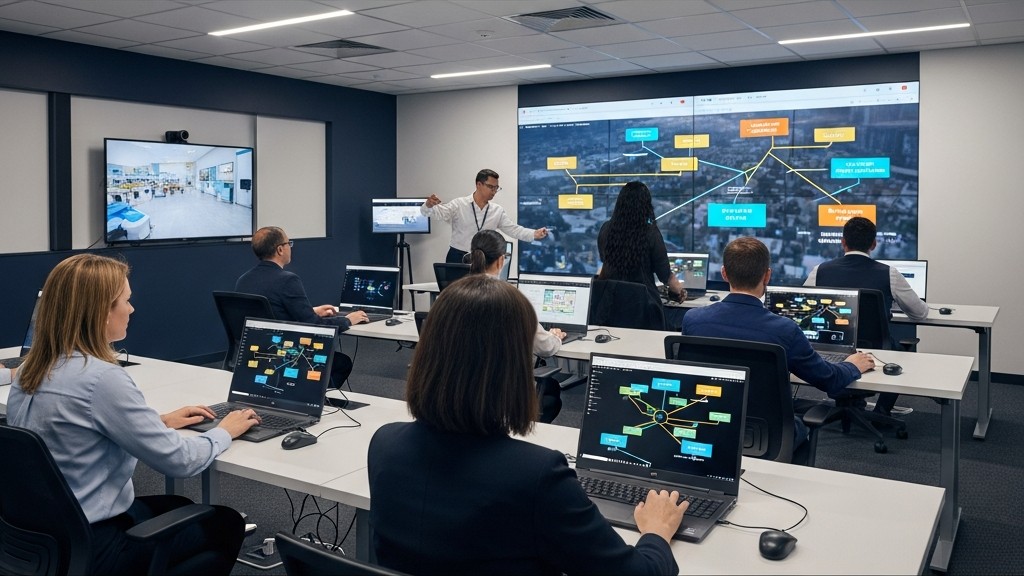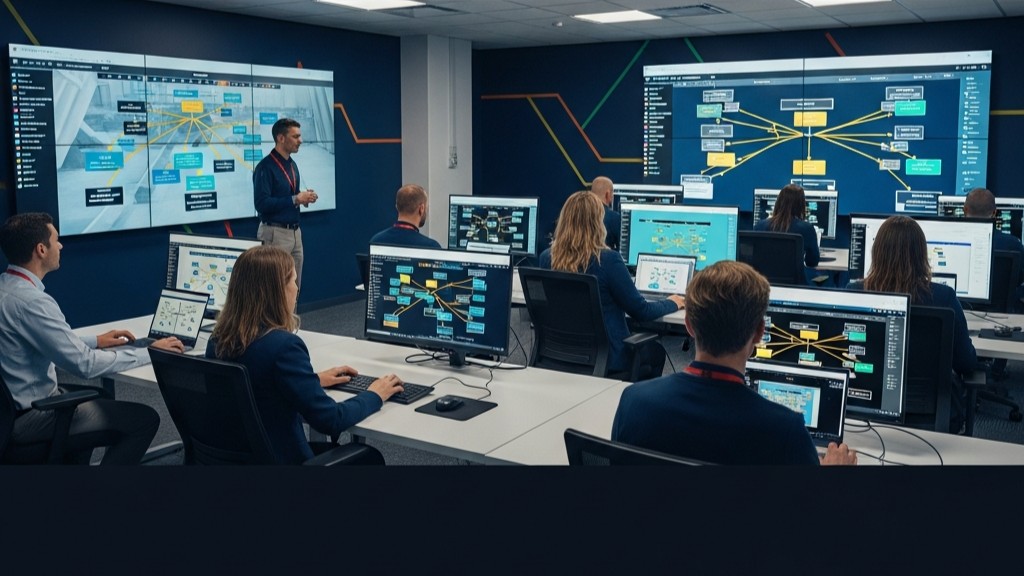Business continuity scenarios: Examples and applications

Testing business continuity plans (BCPs) helps protect both businesses and employees. Scenario-based business continuity testing turns theory into actionable readiness, helping companies mitigate operational threats.
If you haven’t validated your BCP, read on as we cover what business continuity scenarios are, why they matter, and best practices you can adopt.
What are business continuity scenarios, and why do they matter?
Business continuity scenarios simulate operational disruptions to test an organization’s response and recovery strategy. Software solutions make effective scenario-based business continuity training possible, letting personnel practice within a safe, yet realistic environment.
This training centers on operational risk management, as it uncovers issues and vulnerabilities early and ensures personnel can execute critical functions during real-world disruptions. It also strengthens cross-functional coordination, establishes performance benchmarks for continuous improvement, and validates regulatory compliance.
How often should you test your business continuity plan?
Test your BCP frequently enough to keep it aligned with the pace of change in your organization and the threat landscape. At a bare minimum, perform a comprehensive test once every 12 months.
Annual end‑to‑end validation is the threshold most regulators and insurers expect. However, high‑reliability organizations and those in heavily regulated sectors usually adopt a layered schedule that combines multiple exercise types on a rolling basis:
Quarterly tabletop exercises: These are discussion‑based walk‑throughs that define roles, responsibilities, and decision paths for a specific disruption scenario. They function as a low‑impact forum to expose gaps in policies and procedures and refine coordination before real‑world pressure mounts.
Semi‑annual functional or departmental tests: These drills activate a single process or team to validate that critical functions operate as intended. They surface technical or procedural weaknesses early and ensure each component can stand alone under real-world stress.
Annual full‑scale simulation: This exercise recreates an end‑to‑end operational crisis, engaging every business unit and external partner in real time to validate resilience. Its function is to prove that the entire recovery ecosystem—people, technology, and suppliers—can restore operations within agreed Recovery Time Objectives (RTOs).
Ongoing plan reviews: These continual updates verify that contact data, dependencies, and compliance requirements remain current as the organization evolves. Particularly in large organizations and government departments, dedicated teams run exercises throughout the year—keeping the BCP accurate, audit‑ready, and immediately actionable.
4 business continuity scenario-based training examples
BCP scenario-based training covers the operational threat landscape and regulatory obligations, including network outages, data breaches, natural disasters, and supply chain failures.
Network outage: Unplanned network downtime is costly—$9,000 per minute on average for large businesses. Scenario-based training prepares organizations to maintain operational continuity when primary systems fail.
Data breach: Data breaches stem from multiple causes, including weak credentials, unpatched systems, and evolving and costly cyber threats. Scenario-based training simulates detection, containment, and disclosure processes for key operational stakeholders.
Natural disaster: A natural disaster scenario can impact a broad scope of business operations, from on‑site workforce safety to global supply chains. Scenario-based training lets disaster recovery plan stakeholders practice consequential decision-making and multi-stakeholder coordination within a safe environment.
Supply chain failure: Supply chain disruptions don’t just cost 6-10% of annual revenue on average; they also cause reputational damage. Scenario-based drills let key stakeholders walk through contingency steps, including validating backup suppliers, logistics rerouting, and crisis communication processes.
Business continuity plan testing: 3 best practices
Without BCP scenario-based training, your business continuity plan is just theory—and theory doesn't save companies when crisis strikes. Only validated plans and stakeholder preparedness keep operations running.
Here are three best practices that can help you protect your business and its employees, ensuring comprehensive emergency preparedness.
1. Adopt dynamic injects
Design simulation exercises that play out like real-world incidents, rather than scripted walk-throughs. You can achieve this with rich multimedia injects, which significantly increase the realism of scenario-based training. Software solutions, like Avalanche TTX, let you easily build, customize, and release time-sequenced, role-specific injects — from voice prompts to immersive 360-degree video scenes.
Avalanche TTX’s Master Scenario Event List (MSEL) functionality keeps every inject in a timestamped queue. It lets facilitators trigger, edit, or skip events directly from a single dashboard—removing the need for external spreadsheets and keeping the exercise tightly coordinated.
2. Ensure auditability
Exercise documentation has two main purposes: satisfying auditors while generating actionable intelligence on your organization's resilience. Look for scenario-based training solutions that automatically capture each inject, action, and outcome in an immutable audit trail.
The solution should also generate on-demand reports that satisfy regulators and give leadership objective evidence of organizational resilience. Avalanche TTX does just that—it lets you easily export automated simulation reports. To further ensure compliance, the solution lets you map each recorded action to HSEEP or other regulatory frameworks, apply your own report templates, and archive the signed-off results in a tamper-proof repository.
3. Institutionalize continuous improvement
Embed a formal feedback loop into the testing lifecycle. After each exercise, conduct a structured after-action review, capture lessons your teams learned, and translate them into remediation tasks with clearly defined ownership. The objective is to create a measurable improvement cycle where each exercise builds organizational resilience rather than simply checking compliance boxes.
To institutionalize continuous improvement, avoid relying on manual, fragmented processes. Software solutions, like Avalanche TTX, centralize and automate exercise data and governance workflows—letting you govern business continuity easily.
Business continuity scenario training, made easy
Avalanche TTX by Avalias empowers you to mitigate business continuity risk through dynamic, scenario-driven training. Its intuitive platform lets your teams design, execute, and review realistic simulations that far surpass the limitations of traditional tabletop exercise systems.
Don’t wait to ensure your business’s preparedness. Learn more about Avalanche TTX, or reach out to an Avalias team member today.
Frequently asked questions
What are the 4 Ps of BCP?
Business continuity’s 4 Ps are people, processes, premises, and providers. This captures each dependency—workforce, workflows, facilities, and external suppliers–that your business must safeguard to maintain its critical operations.
What is a real-life example of business continuity?
A major, multi-site state U.S. government agency needed to prepare diverse operating units for business continuity scenarios, from ceiling-sprinkler failures that jeopardize files and records to toxic chemical spills caused by nearby freeway accidents. Using Avalanche TTX, the agency delivered over 12 realistic, readily auditable scenario-based exercises in 12 months—significantly improving participant engagement and achieving high cross-functional buy-in.
The state government agency’s business continuity manager noted, “The flexibility of the software allows the facilitator excellent control over the pace of the exercise, incorporating interjections and diversions dictated by group actions. All the action is recorded as the scenario.”
What is a BCP test example?
Simulating a cyberattack is a common BCP test example. It accurately gauges how swiftly teams detect, contain, and recover from a breach, while confirming that communication channels and failover systems keep critical operations running.


